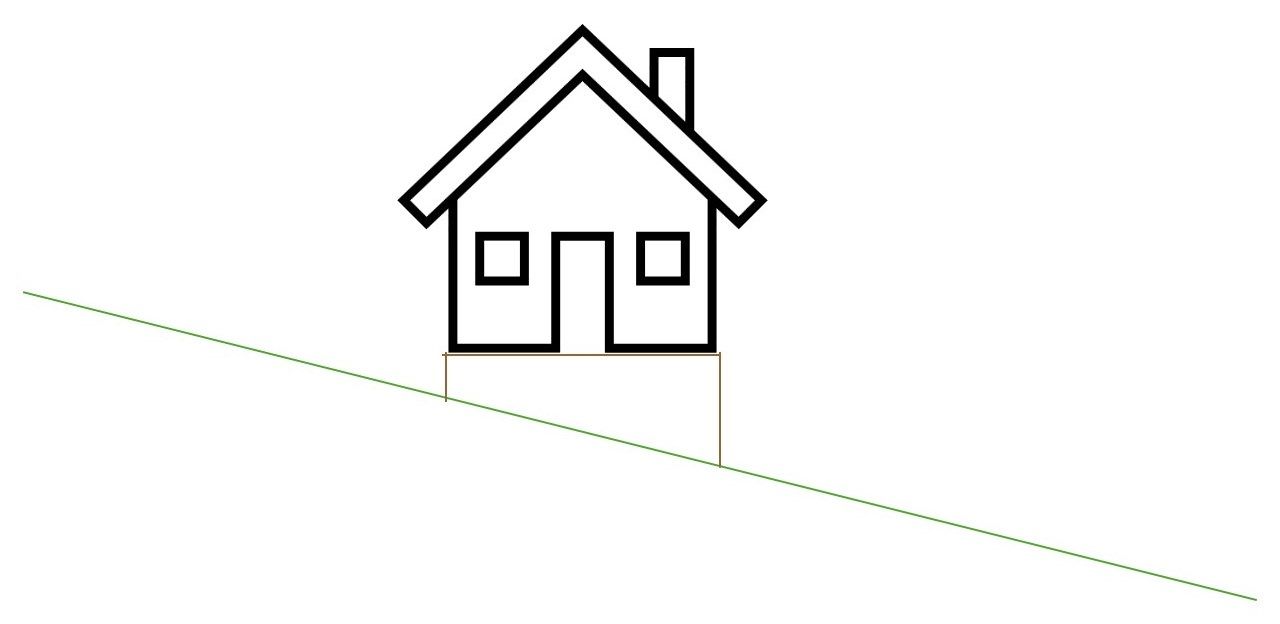In a perfect world, all development sites would be dead flat with perfect soil conditions, easements in the right location, easy access... okay, maybe it's only Property Developers who think like that!
Nature, however, is rather fond of slopes, and so chances are that a site you're assessing won't be flat.
The question, though, is at what point in the continuum between dead flat and the side of a cliff does a site become too steep?
Drum roll please... It depends! Bet you didn't see that coming! Although considering how often people grumble about me answering questions with "it depends", maybe you did.
But it's true! Reality is that you can build just about anywhere. I've seen pods that have somehow been attached to the side of sheer vertical cliffs so climbers have somewhere sheltered to sleep.
It all comes down to dollars. In some ways this harks back to one of my favourite sayings - just because it's developable, doesn't mean it's profitable. And it's the same with slopes. Just because you can build on it, doesn't mean you should.
Building on a Slope
While there are countless ways to solve the issues around building on a slope, it boils down to 3 main options, as well as potentially a combination of approaches:
Poles or Stumps
In this scenario, the slope is left intact, and the house is built out from the slope, supported by stumps if it's a gentle slope, and poles if it's a large slope.
This is often a cheaper option because leaving the slope undisturbed means it's more stable long term, and so doesn't require extra works to reinforce it.

Excavation
The name is something of a giveaway on this one - you cut back into the slope until you've excavated far enough to provide a flat building pad.
While this is quite a simple approach, and is very simple on a gentle slope, as the slope increases the need for engineered retaining walls to hold back the cut slope massively increases too. As do your costs.

Cut and Fill
For this, you cut back into the slope to create part of a flat building pad, then use the excess soil to build up the slope next to the flat pad to make it wider.
Again, this is a strategy that works well on gentle slopes, but costs rapidly rise as the slope increases, as now you have to both retain the slope where it was cut, as well as reinforce the new section of building pad to stop it sliding down the hill.
Factors to Consider
So now that we know how to build on a slope, the question is at what point does doing so stop being a good idea.
As I said earlier, it all comes down to dollars. So you need to think about a number of different factors and how rectifying them is going to impact your end result. Building the basic box of a house is much the same cost no matter where you build it - it's all the other factors added into the mix that make one build more expensive than another.
Foundations
As you can see from the construction options, they all require much more extensive foundations than a standard slab on a flat block. This one bites you twice - more costs in designing the foundations, as well as more cost in building them.
Easements / Services
This is a biggie. On a flat site, as long as the connection points for services are either on or near your site, there's not a lot to be worried about.
When it comes to a slope, it's much more important. General wisdom is that anything that involves water or waste should flow downhill where possible. Yes, I know you can potentially push anything (ahem) uphill if you have to, but that's way more expensive than using gravity to move things along.
Which means that even a gentle slope, if the sewer is at the top of the slope, can be expensive to work with. At the bottom? Gravity is awesome! And cheap.
Earthworks
We've already talked about a few options involving excavation in terms of creating a building pad for your dwelling, but earthworks can rear their head in many other expensive ways.
Does the slope mean you're going to have a steep driveway? You can't just pour a flat concrete driveway, you'll need to move dirt and reinforce the sides and more. Digging service trenches may become more problematic.
Access
While you might have a crossover to the road and plenty of places to store materials, a steep slope can cause issues, whether it's up or down from the road. Not all trucks will be able to navigate a steep drive, which may mean supplies are dumped at the kerb and the builder will need to move them. It may make getting necessary equipment on site difficult.
Landslip
It's worth investigating whether the site has a landslip rating, as this can significantly increase your costs in terms of engineering. The higher the rating, the more that needs to be done to prevent the house from sliding on down the hill.
If you've read this far, you've probably already decided that anything other than the most gentle of slopes is way too much trouble, so why bother?
Well, there's one answer that immediately comes to mind - views! There are times when tackling a hefty slope results in a property with stunning views. And if you're going to be selling the dwellings at the end, views can often add a significant premium to the price of the property. Which makes the extra hassle and cost worthwhile.
So do your area research and your numbers, because that's the best way to answer the question "is the slope on the site too steep?"
Nature, however, is rather fond of slopes, and so chances are that a site you're assessing won't be flat.
The question, though, is at what point in the continuum between dead flat and the side of a cliff does a site become too steep?
Drum roll please... It depends! Bet you didn't see that coming! Although considering how often people grumble about me answering questions with "it depends", maybe you did.
But it's true! Reality is that you can build just about anywhere. I've seen pods that have somehow been attached to the side of sheer vertical cliffs so climbers have somewhere sheltered to sleep.
It all comes down to dollars. In some ways this harks back to one of my favourite sayings - just because it's developable, doesn't mean it's profitable. And it's the same with slopes. Just because you can build on it, doesn't mean you should.
Building on a Slope
While there are countless ways to solve the issues around building on a slope, it boils down to 3 main options, as well as potentially a combination of approaches:
- poles/stumps
- excavation
- cut and fill
Poles or Stumps
In this scenario, the slope is left intact, and the house is built out from the slope, supported by stumps if it's a gentle slope, and poles if it's a large slope.
This is often a cheaper option because leaving the slope undisturbed means it's more stable long term, and so doesn't require extra works to reinforce it.
Excavation
The name is something of a giveaway on this one - you cut back into the slope until you've excavated far enough to provide a flat building pad.
While this is quite a simple approach, and is very simple on a gentle slope, as the slope increases the need for engineered retaining walls to hold back the cut slope massively increases too. As do your costs.
Cut and Fill
For this, you cut back into the slope to create part of a flat building pad, then use the excess soil to build up the slope next to the flat pad to make it wider.
Again, this is a strategy that works well on gentle slopes, but costs rapidly rise as the slope increases, as now you have to both retain the slope where it was cut, as well as reinforce the new section of building pad to stop it sliding down the hill.
Factors to Consider
So now that we know how to build on a slope, the question is at what point does doing so stop being a good idea.
As I said earlier, it all comes down to dollars. So you need to think about a number of different factors and how rectifying them is going to impact your end result. Building the basic box of a house is much the same cost no matter where you build it - it's all the other factors added into the mix that make one build more expensive than another.
Foundations
As you can see from the construction options, they all require much more extensive foundations than a standard slab on a flat block. This one bites you twice - more costs in designing the foundations, as well as more cost in building them.
Easements / Services
This is a biggie. On a flat site, as long as the connection points for services are either on or near your site, there's not a lot to be worried about.
When it comes to a slope, it's much more important. General wisdom is that anything that involves water or waste should flow downhill where possible. Yes, I know you can potentially push anything (ahem) uphill if you have to, but that's way more expensive than using gravity to move things along.
Which means that even a gentle slope, if the sewer is at the top of the slope, can be expensive to work with. At the bottom? Gravity is awesome! And cheap.
Earthworks
We've already talked about a few options involving excavation in terms of creating a building pad for your dwelling, but earthworks can rear their head in many other expensive ways.
Does the slope mean you're going to have a steep driveway? You can't just pour a flat concrete driveway, you'll need to move dirt and reinforce the sides and more. Digging service trenches may become more problematic.
Access
While you might have a crossover to the road and plenty of places to store materials, a steep slope can cause issues, whether it's up or down from the road. Not all trucks will be able to navigate a steep drive, which may mean supplies are dumped at the kerb and the builder will need to move them. It may make getting necessary equipment on site difficult.
Landslip
It's worth investigating whether the site has a landslip rating, as this can significantly increase your costs in terms of engineering. The higher the rating, the more that needs to be done to prevent the house from sliding on down the hill.
If you've read this far, you've probably already decided that anything other than the most gentle of slopes is way too much trouble, so why bother?
Well, there's one answer that immediately comes to mind - views! There are times when tackling a hefty slope results in a property with stunning views. And if you're going to be selling the dwellings at the end, views can often add a significant premium to the price of the property. Which makes the extra hassle and cost worthwhile.
So do your area research and your numbers, because that's the best way to answer the question "is the slope on the site too steep?"
